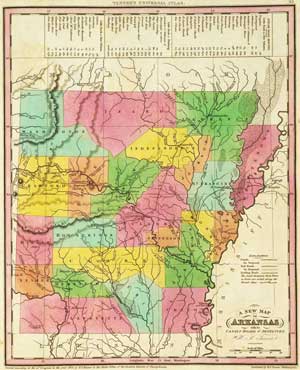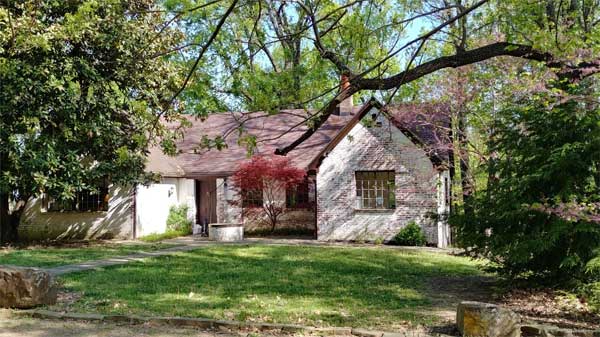Evangeline’s Cottage on Markham Hill
|
Community Radio show aired on KPSQ 97.3 FM: |
Extracted from early 1999 United States Department of the Interior, National Park Service, National Register of Historic Places Registration Form for the Waterman-Archer House which was approved in mid-1999.
Northwest Arkansas in the first three decades following the Louisiana Purchase in 1803 was a part of the Arkansas Territory reserved for Indian habitation. Soon Cherokees from the eastern United States settled there, though very sparsely. In the 1820s pressure to open this land to white settlement mounted and in 1827 the Secretary of War issued an order allowing white habitation, which resulted in the Cherokees being forced to move farther west. The area was then known as Lovely's Purchase (sometimes called Lovely Purchase) and on October 13, 1827, the Arkansas Territorial Legislature created a huge county in northwest Arkansas known as Lovely County. A year later the name was changed to Washington County and court was held at a small settlement, the future site of Fayetteville, but initially named simply Washington County Court.
A few years later (1834) the commissioners of the courthouse petitioned the federal government to issue a patent (i.e. articles of incorporation) and an executive order of February 27, 1835, signed by President Andrew Jackson, honored the request. Because two of the commissioners were from Fayetteville, Lincoln County, Tennessee, the county seat of that state, it was decided to name the Washington County seat after their hometown.
In 1836, quite likely due to the rapid settlement of northwest Arkansas, the Arkansas legislature rearranged boundaries by reducing Washington County to its present size and created Benton and Madison Counties and gave more land to Carroll County. Though nearly destroyed in the Civil War, Fayetteville grew rapidly in the last third of the nineteenth century, especially with the establishment of the State University there in 1871 and then by the arrival of the St. Louis and San Francisco Railroad. By 1889 it had a population of almost 4,000, a century later almost 50,000 and now, along with the rest of northwest Arkansas, is one of the most rapidly growing areas in the state.
[The Pratt family settled on what now is known as Markham Hill in 1900.]
Evangeline Pratt, the youngest of six Pratt children, graduated from the University of Arkansas, Fayetteville in 1919 and became Director of the Bureau of Women’s Clubs of the University's General Extension Division. She attended the University at a time when few women did so and assumed a managerial position when it was rare for women to work outside the home. In the 1920s she met Julian S. Waterman, a professor of economics at the University of Arkansas, Fayetteville, who had just earned a law degree from the University of Chicago. At the request of then University President Futrall, Waterman established the law school at Fayetteville in 1924 and became its first Dean, a position he held until his death in 1943.
In 1927 Evangeline Pratt and Julian Waterman were married, and they built a house in 1929 on property Mrs. Waterman's father had given her. The house was ideally situated for this couple because it was within walking distance of the University, yet remote enough to seem completely rural, with the further advantage of being just four-hundred yards from the Pratt homestead. There is no evidence of an architect or a draftsman being involved in the design of the house; indeed, Mrs. Waterman always described the house as being of her own design. There is a sketch among family papers of a simple floor plan; but no record of who the builder was. Dean Waterman went on to hold a variety of posts in the legal profession, became Vice-President of the University in 1937, and was Vice-President and later President of the Southwest Athletic Conference.
Widowed by the sudden death of Dean Waterman from a strangulated hernia, Mrs. Waterman and her young son Julian continued to live in the house. In 1947 she married Laird Archer, Foreign Director of the Near East Foundation, a private philanthropic organization whose overseas headquarters was in Athens, Greece. She and her son moved to her new husband’s home in Athens where they lived until Laird Archer's retirement in 1952, whereupon they returned to Fayetteville to live. Laird Archer was active lecturing and writing in his retirement years and Evangeline became involved in statewide preservationist causes, first with the Nature Conservancy and then with the Ozark Society. She was a founding member of the latter, serving as its corresponding secretary from its beginning in1962 until 1972, and stepping down only after Congress made the Buffalo River a National River. She died in 1979; Laird Archer in 1981.
The property passed by inheritance in 1979 to the sole heir, Julian Pratt Waterman Archer, who has maintained the Waterman-Archer House ever since, as well as the adjacent Pratt family homestead (Listed on the Arkansas State Register, April 7, 1999). The property is now within the city limits of Fayetteville, actually well within the city limits, which have been extended several miles to the west. It continues to retain its rural appearance, however, because all of the surrounding property still is in the family and the adjacent woods have been preserved. There never have been any through-streets cut across this property, so the area remains almost a secret corner of Fayetteville.
The 1929 Waterman-Archer House is an intact example of Tudor architecture. The brick cottage on Sassafras Hill in Fayetteville is composed of an unusual floor plan yet displays simple lines in its gabled wings and airy fenestration. The home's surroundings, which have been allowed to remain natural, contribute to the integrity of the cottage and give one a sense of its construction as an early twentieth-century country house. As an example of a well-maintained Tudor Cottage, the Waterman-Archer House is being nominated to the National Register under Criterion C with local significance.

